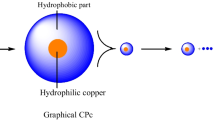Abstract
This paper demonstrates Pseudomonas cepacia lipase catalyzed hydrolysis of p-nitrophenyl palmitate under irradiation of light with wavelengths of 250–750 nm. The reaction follows Michaelis–Menten Kinetics and the light irradiation increases the overall rate of hydrolysis. Using Lineweaver–Burk plot K M and V max values for the reaction in presence of light are found to be 39.07 and 66.67 mM/min/g, respectively; while for the same reaction under dark condition, the values are 7.08 and 10.21 mM/min/g. The linear form of enzyme dependent rate of reaction confirms that no mass-transfer limitations are present and the reaction is a kinetically controlled enzymatic reaction.






Similar content being viewed by others
References
Joseph B, Ramteke PW, Thomas G (2008) Cold active microbial lipases: some hot issues and recent developments. Biotechnol Adv 26:457–470
Gutierrez CA, Carelli AA, Ferreira ML (2007) Relation between lipase structures and their catalytic ability to hydrolyse triglycerides and phospholipids. Enzym Microb Technol 41:35–43
Bana K, Hamab S, Nishizuka K, Kaieda M, Matsumoto T, Kondo A (2002) Repeated use of whole-cell biocatalysts immobilized within biomass support particles for biodiesel fuel production. J Mol Catal B Enzym 17:157–165
Marıa PD, Sanchez JM, Sinisterra JV, Alcantara AR (2006) Understanding Candida rugosa lipases: an overview. Biotechnol Adv 24:180–196
Saxena RK, Sheoran A, Giri B, Davidson WS (2003) Purification strategies for microbial lipases. J Microbiol Methods 52:1–18
Murthy V, Julien P, Gagne C (1996) Molecular pathobiology of the human lipoprotein lipase gene. Pharmacol Ther 70:101–135
Soumanou M, Bornscheuer UT (2003) Improvement in lipase-catalyzed synthesis of fatty acid methyl esters from sunflower oil. Enzym Microb Technol 33:97–103
Iso M, Chen B, Eguchi M, Kudo T, Shrestha S (2001) Production of biodiesel fuel from triglycerides and alcohol using immobilized lipase. J Mol Catal B Enzym 16:53–58
Xu Y, Du W, Zeng J, Liu D (2004) Conversion of soybean oil to biodiesel fuel using lipozyme TL IM in a solvent-free medium. Biocatal Biotransform 22:45–48
Dossat V, Combes D, Marty A (2002) Efficient lipase catalysed production of a lubricant and surfactant formulation using a continuous solvent-free process. J Biotechnol 97:117–124
Purec L, Krasna AI (1967) The activation of the hydrogenase of proteus vulgaris by visible light. Proceedings of the National Academy Sciences of the USA 57:1416–142
Fenyo M (1984) Theoretical and experimental basis of biostimulation. Opt Laser Technol 16:209–215
Fiedorowicz M, Chaczatrian G (2003) Effect of illumination with the visible polarized and non-polarized light on R-amylolysis of starches of different botanical origin. J Agric Food Chem 51:7815–7819
Kertesz I, Fenyo M, Mester E, Bathori G (1982) Hypothetical physical model for laser biostimulation. Opt Laser Technol 14:31–32
Kordel M, Hofrnam B, Schomburg D, Schmid RD (1991) Extracellular lipase of Pseudomonas sp. strain ATCC-21808, purification, characterization, crystallization, and preliminary X-ray diffraction data. J Bacteriol 173:4836–4841
Pencreac’h G, Baratti C (1996) Hydrolysis of p-nitrophenyl palmitate in n-heptane by the Pseudomonas cepacia lipase: a simple test for the determination of lipase activity in organic media. Enzym Microb Technol 18:417–422
Kyeong KK, Hyun KS, Dong HS, Kwang YH, Se WS (1997) The crystal structure of a triacylglycerol lipase from Pseudomonas cepacia reveals a highly open conformation in the absence of a bound inhibitor. Structure 5:173–185
Bruno LA, Pinto GAS, Catro HF, Filho JL, Mclo EHM (2004) Variables that affect immobilization of Mucor Miehei lipase on nylon membrane. World J Microbiol Biotechnol 20:371–375
Jeremy MB, John LT, Lubert S (2010) Biochemistry. W.H Freeman, New York
Carnahan B, Luther HA, Wilkes JO (1969) Applied numerical methods. Wiley, New York
Acknowledgments
The authors gratefully thank to Ministry of Education, Malaysia and Universiti Malaysia Pahang for financial support through GRS 120347.
Author information
Authors and Affiliations
Corresponding author
Rights and permissions
About this article
Cite this article
Ganasen, P., Khan, M.R., Kalam, M.A. et al. Effect of visible light on catalytic hydrolysis of p-nitrophenyl palmitate by the Pseudomonas cepacia lipase immobilized on sol–gel support. Bioprocess Biosyst Eng 37, 2353–2359 (2014). https://doi.org/10.1007/s00449-014-1213-6
Received:
Accepted:
Published:
Issue Date:
DOI: https://doi.org/10.1007/s00449-014-1213-6




